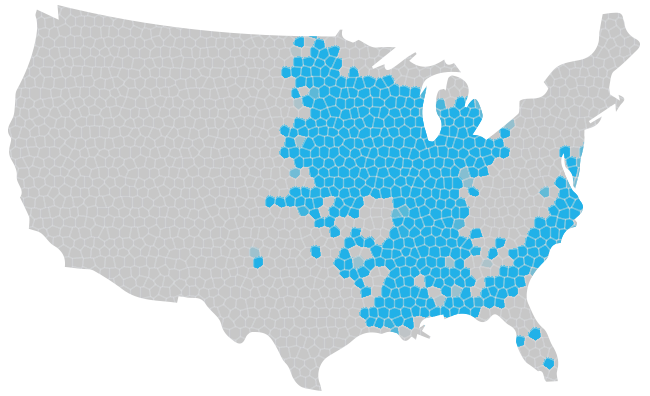
UNPARALLELED ARTIFICIAL INTELLIGENCE
FOR FARMS ACROSS THE GLOBE
Farmers all over the world face an invisible problem. Below ground, parasites and soil diseases are impacting crop production. Until now, farmers had few options in combating these crop issues. Now, they have an Artificial Intelligence solution on their side.
SCROLL DOWN
SCIENTIFICALLY SUPERIOR
The Artificial Intelligence that QMIRA™ developed uses a dynamic system to identify, diagnose, and intervene in crop infections.
Through this revolutionary technology, farmers and others in the agricultural sector have a point of product intervention to combat crop infections by scanning the soil, diagnosing undetected parasites and diseases, and treating with the right intervention.
EASY TO IMPLEMENT & USE
SCAN
Drones and agBots can work together or independently to scan crops and soils as they search for signs and symptoms of infection.
DIAGNOSE
As the drones fly over the field scanning for signs of infection, the agBots are in the field taking soil samples and assessing the situation below ground.
TREAT
The Artificial Intelligence technology distinguishes between infected and uninfected plants to make treatment more effective and stop the infections from spreading. Farmers are also able to monitor the speed and efficacy of treatments.
ULTRA-EFFICIENT
Now, every farmer is a scientist that can diagnose and treat their crops.
With our revolutionary technology, farmers have a solution to their crop issues. Using the drone and agBot to scan, diagnose, and treat their crops, farmers have more control of their future yields and their finances.
- Spend less money treating crops with biochemicals
- Avoid treating crops that aren’t plagued by parasites
- Stop replanting crops that have been destroyed by infections
- Perform management solutions to save on reseeding
- Prevent new infections with routine scans
- Increase current and future yields by treating infections now
Would you like to learn more about agricultural innovations in the works? Join the agBOT Challenge!
A CASE STUDY
The Soybean Cyst Nematode
INTRODUCTION
ROOT KNOT NEMATODE IN SOYBEANS
U.S. farmers plant 83.4 million acres of soybean every year, and by 2020, the soybean market is expected to reach almost $25 billion. All of those farmers face a common threat: Root Knot Nematode, one of the 3 most economically damaging plant parasites on earth.
- There are at least 4,100 different species of nematodes.
- Nematodes account for an average of 12.3% of crop loss globally.
- Females can lay 500 to 1,000 eggs, which mature to reproducing adults in as few as 21 days.

PROBLEM
NEGATIVE IMPACT ON FARMERS & CROPS
- Infection can devastate the entire year’s yield and overall farm operation.
- Infected young plants can be killed, while infected mature plants experience 5% yield decrease.
- Nematode eggs can survive through winter, impacting future seasons.

DIAGNOSING THE ISSUE
- Symptoms begin underground, which means yields are lost by the time farmers even notice an issue.
- Checking every plant once per season is usually impossible.
- Once diagnosed, farmers treat entire fields for an infection that may not affect the entire crop.
- Treating crops for Root Knot Nematode is difficult, time-consuming, and expensive.
Nematodes cause 12-17% yield loss on a global scale each year.
Root Knot Nematode is responsible for an estimated 10.6% yield loss in soybeans
SOLUTION
ARTIFICIAL INTELLIGENCE FROM QMIRA™
With our technology, soybean farmers prevent crop and yield loss in the current and future seasons. In fact, they’ll have fewer replants, which makes their operation more eco-friendly and cost-effective.
- Scientifically superior technology that accurately diagnoses the problem.
- Easy to implement and use for any size of farming operation across the globe.
- Ultra efficient to increase crop yields and decrease operational expenses.
% FEWER REPLANTS
Farmers using Artificial Intelligence from QMIRA™ can expect 75% fewer replants.
DOLLARS PER ACRE
Artificial Intelligence from QMIRA™ allows farmers to save more than $26 per acre, excluding seed costs.
THE FUTURE
THE SOYBEAN MARKET
Billions Of $
With the soybean market expected to reach almost $25 billion by 2020, farmers around the globe need a solution to invisible threats, like the Root Knot Nematode. Artificial Intelligence provides a world-class solution that any farmer can implement to keep crops protected.
APPLYING THE TECHNOLOGY

The Artificial Intelligence that QMIRA™ developed can be universally and effectively applied to agricultural operations of all sizes around the globe. Because nematodes, other parasites, and soil diseases impact more crops than just soybeans, our technology can be used to increase yields in additional crop varieties.
REVOLUTIONIZE AG WITH US
QMIRA™ IS BUILDING A MORE INTELLIGENT FUTURE
Are you ready to be part of that future? Contact our team for more information about distribution.
